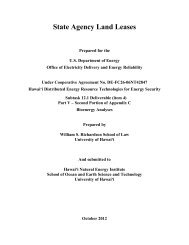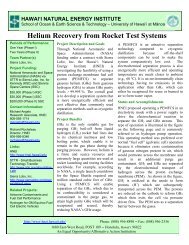Oahu Wind Integration Study - Hawaii Natural Energy Institute ...
Oahu Wind Integration Study - Hawaii Natural Energy Institute ...
Oahu Wind Integration Study - Hawaii Natural Energy Institute ...
You also want an ePaper? Increase the reach of your titles
YUMPU automatically turns print PDFs into web optimized ePapers that Google loves.
1.3. Challenges of operating <strong>Oahu</strong>’s system with high levels of wind power<br />
Large-scale wind power presents several potential challenges for operating a power system,<br />
particularly small island grids like the <strong>Oahu</strong> electrical system. This section describes some of<br />
these challenges and begins by discussing operation of the baseline system without any<br />
substantial variable renewable energy generation. Figure 1-3 illustrates the system load profile<br />
for a typical week for the <strong>Oahu</strong> system in a future year without any large wind or solar PV<br />
projects.<br />
7 days<br />
Figure 1-3. An example of operation for the Baseline 2014 <strong>Oahu</strong> power system<br />
The graph shows the system load at a given point in time and the colors depict the dispatch of<br />
generating units to meet the load. The load profile of <strong>Oahu</strong> is characteristic of a residential<br />
customer base as tourism has a strong influence on the commercial sector. As such, system load<br />
does not deviate much from its profile. The system minimum load typically occurs from 10pm<br />
to 6am. The system day peak occurs between 12pm and 1pm and load remains relatively<br />
constant until the night peak between 6pm and 7pm.<br />
Generating units are characterized by three modes of operation: baseload, cycling and peaking.<br />
The baseload units are generally the largest and least-cost units to operate and remain online<br />
continuously throughout the year. These units are economically dispatched to meet system load.<br />
In Figure 1-3 the baseload units are situated at the bottom of the figure and consist of the<br />
Kalaeloa Combined Cycle plant, AES steam plant, and Kahe and Waiau reheat steam units. A<br />
small amount of baseload energy is provided by HPower (waste to energy), Honua (gasification)<br />
and OTEC (Ocean Thermal <strong>Energy</strong> Conversion). Honua and OTEC are not presently in<br />
operation, but were assumed to be in this future study year.<br />
Cycling units are smaller, non-reheat steam units. The cycling units are committed and<br />
shutdown daily to meet system demand and typically provide system up-reserves. The blue area<br />
represents cycling unit generation. The three peaking units are combustion turbines. These units<br />
are fueled by diesel fuel (Waiau 9 and Waiau 10) and biofuel (CIP-CT1). Four customer-owned<br />
diesel units can also provide peaking service. Peaking units are characterized as fast-start<br />
generation and are committed to meet peak demand and for system emergencies.<br />
The baseload plants remain online consistently and respond to a reduction in demand (load) in<br />
the off-peak period by reducing their power output. Each unit has a limit on how low it can<br />
8




